
Here are some of the earliest Mephisto sensor boards I owned and tested
For some pure nostalgia, take a look at the unboxing, setup and operation of the famous Mephisto Millennium. And this is the massive Fidelity sensor board I was given.
How things have changed! Recently, an ad for the DGT Centaur caught my eye. I have had a very long and friendly relationship with the company that supplies virtually all the sensor boards that are used in top-class tournaments. I told them I would like to experiment with their new chess playing sensor board, in a children's chess group that had formed in an elite school in Hamburg. The owner and CEO of DGT, Hans Pees, immediately offered to send me a set. And this is what I got:
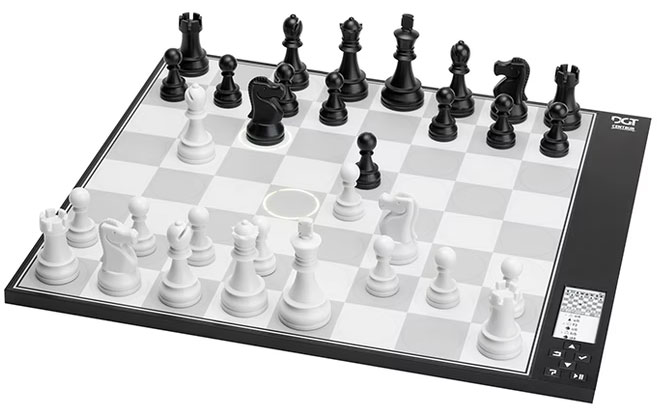
The Centaur is flat – just 1.2 cm thick, and light – 90 grams without the pieces. It makes a very sleek and elegant impression. Its operation could not be simpler: you set up the pieces and press the start button. No connection to the mains required. The board runs on a built-in battery that uses a standard USB charger. My set came pre-charged, and now, some weeks after receiving it, I have yet to connect it to USB (Hans, does it run forever?).
With the pieces in the initial position, the board knows you want to play a game. Enter a move, and it signals a reply, using discrete circular lights on the chessboard.
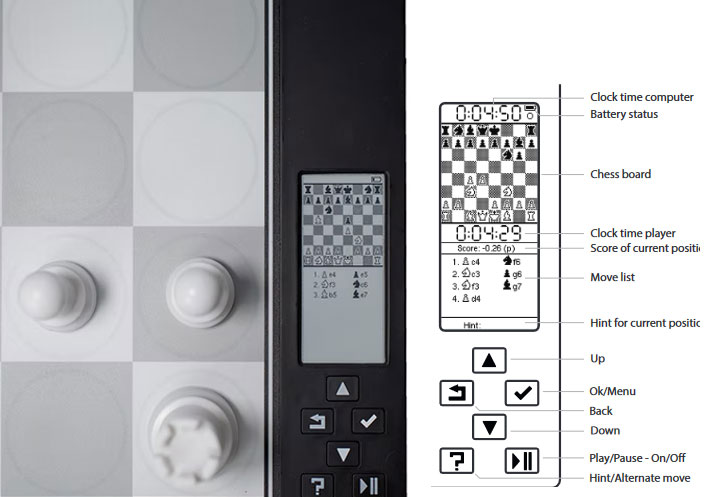
A small screen on the right displays the current status of the game. The schematics on the right (from the instruction manual) show the functions of the display and keys.
I grew quite fond of the operation of the Centaur. If you make a mistake, you can simply take back a couple of moves. The sensor board and understands what you want, and you can play an alternative. If you make an illegal move the "from" and "to" squares flash, telling you to take back the move and play something legal. To start a new game, just put the pieces back to the original squares. No key presses are required for all these operations.
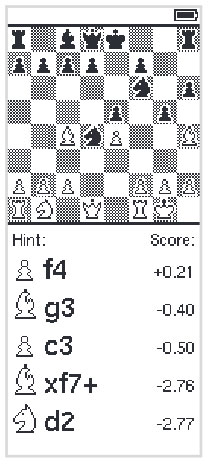 There is one key you might want to occasionally use: the question mark button provides you with hints. It also displays how good or bad it thinks these moves are.
There is one key you might want to occasionally use: the question mark button provides you with hints. It also displays how good or bad it thinks these moves are.
Another neat feature: you can simply switch off the board, using the on/off button, to adjourn a game. When you switch the set back on, it is ready to continue the game from where you left off.
Centaur has three playing modes: Friendly, Challenging and Expert. The default is Friendly, but you can change it at any time, even during a game.
"Friendly" gives you chance to win. As with Fritz 18, the Centaur will try to match your playing strength. If you lose a game it becomes weaker, if you win it will be stronger in the next game.
"Challenging" is more demanding. I think it sets itself to match your level of play, but will itself be slightly stronger, making good moves more often.
"Expert" is full strength, which means you have very little chance of winning. It clearly doesn't care how strong or weak you are.
Initially, in Friendly mode, I lost all games. Then suddenly I won one, much in the style of games against Fritz 18. And then another, and another. That was quite motivating. Just like with traditional chess programs, it has been decades since something like this was remotely possible. For amateurs, at least.
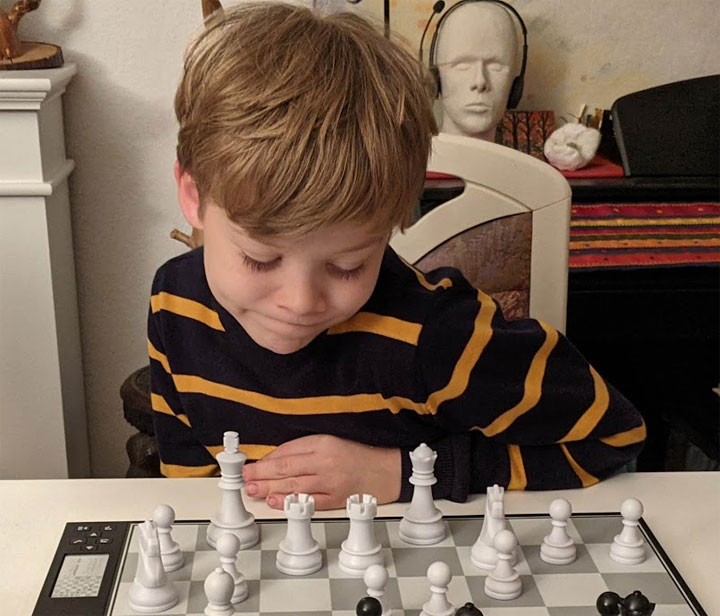 And that brings me to the only complaint I have with the DGT Centaur. I showed it to the chess class (eight-year-olds and younger). They were absolutely delighted, and played game after game. But they didn't have the ghost of a chance of actually winning any of them. Why?
And that brings me to the only complaint I have with the DGT Centaur. I showed it to the chess class (eight-year-olds and younger). They were absolutely delighted, and played game after game. But they didn't have the ghost of a chance of actually winning any of them. Why?
Because chess beginners lose games by dropping pieces, not seeing that they can be captured. It is the last thing the Centaur itself would do. So the computer diligently takes the pieces that are en prise and in the end can do nothing but win the game.
After ten or more games, the rank amateurs gave up – they lost interest in playing against the machine.
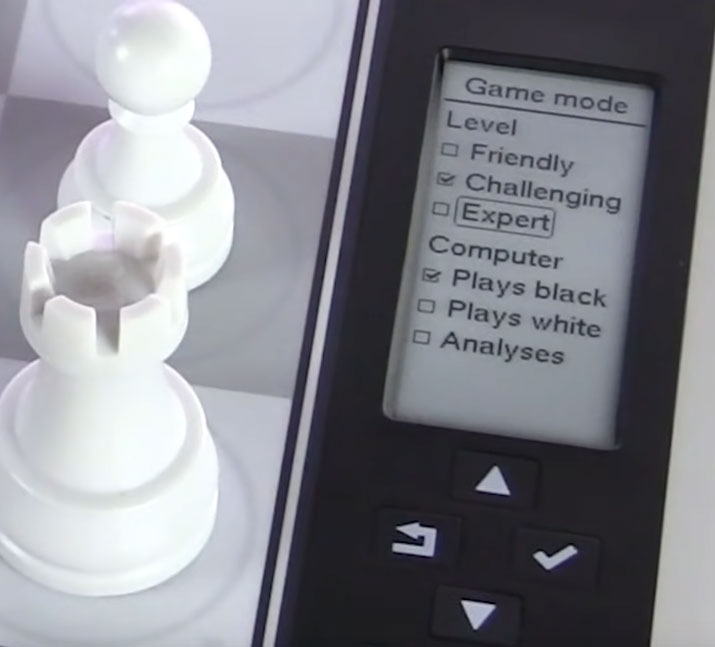 So my request to DGT: get your programmers to install a "Beginner" mode, in which the board will actually drop pieces – just like the rank beginners in the chess group I was experimenting with constantly do. I will help you to devise algorithms to make plausible oversights by the computer. They should mimic the type of mistakes people who have just learnt the game tend to make. A Beginner mode will make the set available to a much larger, and very important, target group.
So my request to DGT: get your programmers to install a "Beginner" mode, in which the board will actually drop pieces – just like the rank beginners in the chess group I was experimenting with constantly do. I will help you to devise algorithms to make plausible oversights by the computer. They should mimic the type of mistakes people who have just learnt the game tend to make. A Beginner mode will make the set available to a much larger, and very important, target group.
The CEO of DGT explained:
"One thing perhaps to point out is that Centaur adapts itself to the player immediately during the game, but not so much from game to game. There is a very small adaptation from one game to the next, but that adaptation is not significant. And in any case it is reset as soon as Centaur is restarted or when another “level” is selected.
So basically if one player plays a game against Centaur it will adapt to the current player’s strength at once. If for the next game a different player plays against Centaur, it will adapt to this new player at once (and more or less completely forget about the previous game and the previous player).
Perhaps this is also a reason why absolute beginners find it quite challenging to win or draw their first game. But when they do draw or even win their first game, the delight is immense."
While absolute beginners might struggle against the Centaur, I must hasten to mention that the Centaur is perfectly suited to anyone who is approaching or has slightly exceeded Elo 1000. And of course also for players who are much stronger. That is my initial estimation. For anyone in these categories the board is loads of fun. Here's a video with full operational instructions.
You can get the Centaur from a DGT dealer, or outlets like Amazon. The price is $288.
Coming soon: review of a second modern sensor board that is similarly sleek and attractive.





















 There is one key you might want to occasionally use: the question mark button provides you with hints. It also displays how good or bad it thinks these moves are.
There is one key you might want to occasionally use: the question mark button provides you with hints. It also displays how good or bad it thinks these moves are. And that brings me to the only complaint I have with the DGT Centaur. I showed it to the chess class (eight-year-olds and younger). They were absolutely delighted, and played game after game. But they didn't have the ghost of a chance of actually winning any of them. Why?
And that brings me to the only complaint I have with the DGT Centaur. I showed it to the chess class (eight-year-olds and younger). They were absolutely delighted, and played game after game. But they didn't have the ghost of a chance of actually winning any of them. Why? So my request to DGT: get your programmers to install a "Beginner" mode, in which the board will actually drop pieces – just like the rank beginners in the chess group I was experimenting with constantly do. I will help you to devise algorithms to make plausible oversights by the computer. They should mimic the type of mistakes people who have just learnt the game tend to make. A Beginner mode will make the set available to a much larger, and very important, target group.
So my request to DGT: get your programmers to install a "Beginner" mode, in which the board will actually drop pieces – just like the rank beginners in the chess group I was experimenting with constantly do. I will help you to devise algorithms to make plausible oversights by the computer. They should mimic the type of mistakes people who have just learnt the game tend to make. A Beginner mode will make the set available to a much larger, and very important, target group.




